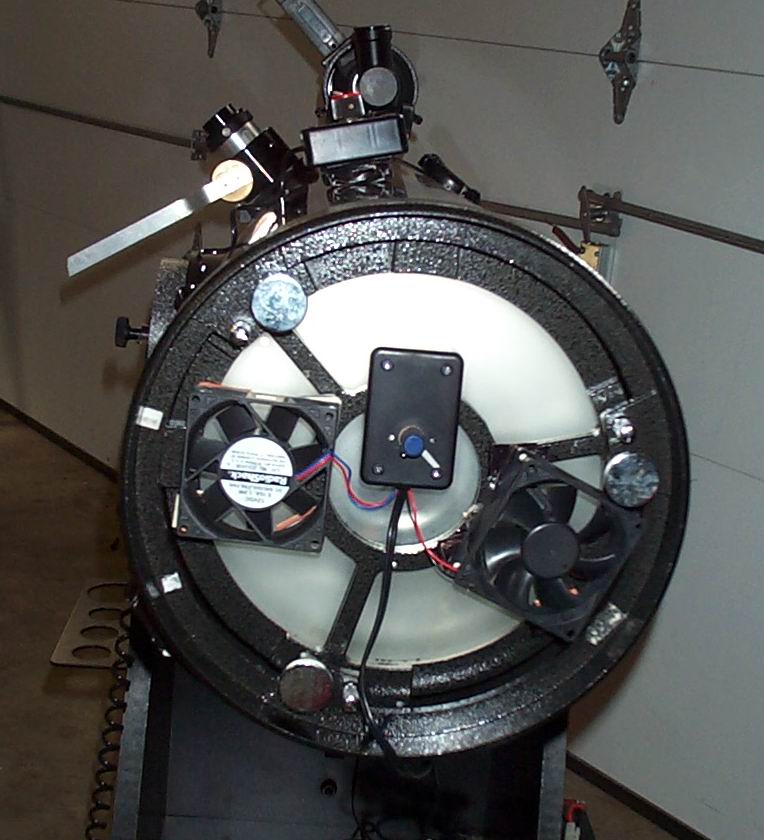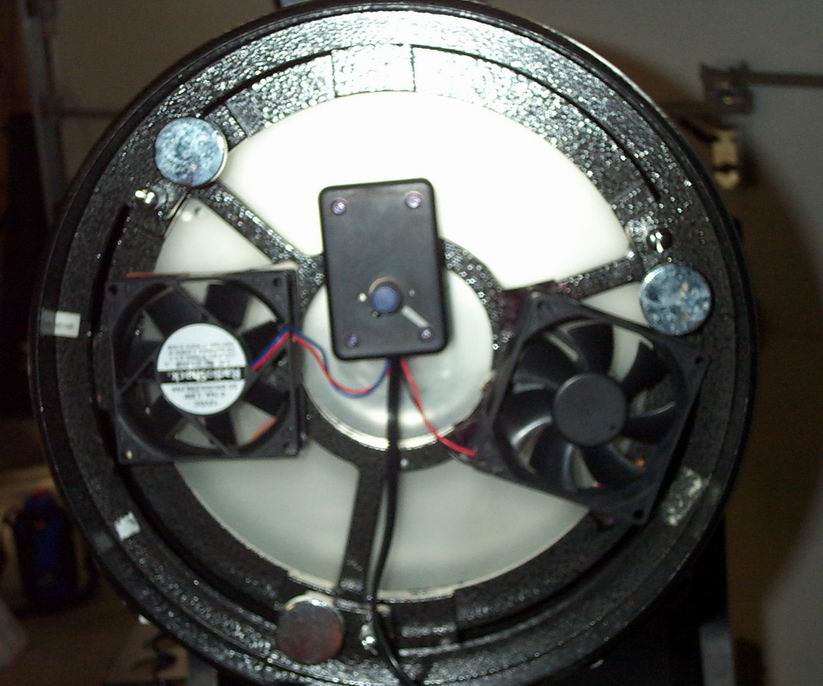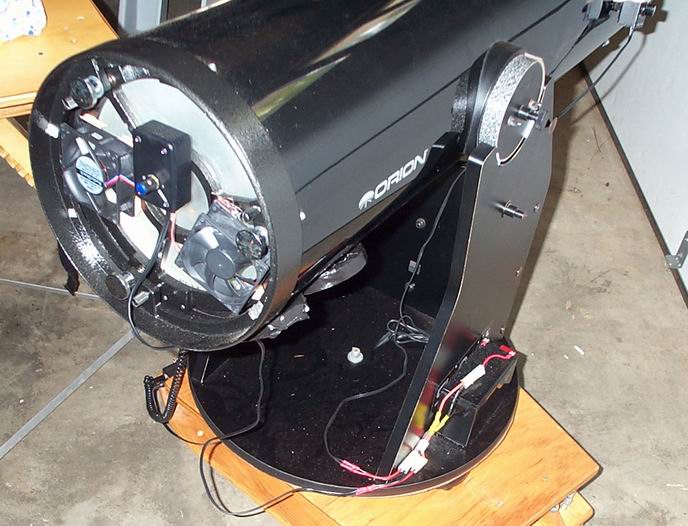Ok, a little more required reading before we get started: Thermal management In addition, the author of this article, Bryan Greer, has made some videos available online that show real time the thermal effects on a newtonian mirror. These are big, but well worth a look if you still aren’t convinced of the thermal goings on inside a dobsonian tube.
This is the background that got Gene Baraff and I started on a quest. The quest was how to actively manage the thermal characteristics of an XT10 without hacking into the OTA. The solution we came up with is quite simple and very effective.
Here is a document put together by Gene on the Skyquest group. I took the liberty of putting it all together, including pictures.
Gene’s installation. Both fans are blowing. Powered by 2 9V batteries in parallel:




There are a couple differences in how I implemented my thermal system. Here are some pics:



The left fan is sucking and the right one is blowing. The fans are just computer fans bought from Radio Shack and hocked from an old computer. I attached my fans with sorbathane and double sided tape. The sorbathane is an excellent vibration isolation substance. It’s the same stuff that Orion, Celestron and Meade use in their vibration suppression pads. I acquired my sorbathane from my running shoes. The inserts are made of sorbathane. I cut little triangles of it out and put double sided tape on both sides. This is what’s holding my fans on the back of the XT10. This has proven very effective at eliminating all vibration from the fans. I have run the fans at full speed (12 volts) and not seen any vibration in the eyepiece at up to 500x.
The little black box in the middle is a project box from Radio Shack. Inside is a 5k pot with an on/off switch mounted on the back. The pot is just in series with the fans. This allows me to adjust the speed of the fans. The fans will run down to about 6 volts. The mark on the box shows where I will get the fans to just turn on. The fans are powered by a Panasonic 12v, 7 Ah sealed lead acid battery that I bought from Parts Express. This battery also powers my Kendrick dew prevention system.
I chose the suck/blow configuration because that is how I originally installed the fans. I was able to verify that there was significant airflow across the center of the primary even with the fans running at 6 volts. Plus, I’m just too lazy to turn the one fan around. It works, so I’ll leave it.
Gene’s mechanical implementation is much more elegant than mine, but they both work. And they work very well. I have verified quantitatively and qualitatively that this system effectively eliminates tube currents and the boundary layer that can form on the primary. It is as effective as cutting holes, without the unsightly modifications. It has the added benefit of greatly reducing cool down times.
The left fan is sucking and the right one is blowing. The fans are just computer fans bought from Radio Shack and hocked from an old computer. I attached my fans with sorbathane and double sided tape. The sorbathane is an excellent vibration isolation substance. It’s the same stuff that Orion, Celestron and Meade use in their vibration suppression pads. I acquired my sorbathane from my running shoes. The inserts are made of sorbathane. I cut little triangles of it out and put double sided tape on both sides. This is what’s holding my fans on the back of the XT10. This has proven very effective at eliminating all vibration from the fans. I have run the fans at full speed (12 volts) and not seen any vibration in the eyepiece at up to 500x.
The little black box in the middle is a project box from Radio Shack. Inside is a 5k pot with an on/off switch mounted on the back. The pot is just in series with the fans. This allows me to adjust the speed of the fans. The fans will run down to about 6 volts. The mark on the box shows where I will get the fans to just turn on. The fans are powered by a Panasonic 12v, 7 Ah sealed lead acid battery that I bought from Parts Express. This battery also powers my Kendrick dew prevention system.
I chose the suck/blow configuration because that is how I originally installed the fans. I was able to verify that there was significant airflow across the center of the primary even with the fans running at 6 volts. Plus, I’m just too lazy to turn the one fan around. It works, so I’ll leave it.
Gene’s mechanical implementation is much more elegant than mine, but they both work. And they work very well. I have verified quantitatively and qualitatively that this system effectively eliminates tube currents and the boundary layer that can form on the primary. It is as effective as cutting holes, without the unsightly modifications. It has the added benefit of greatly reducing cool down times.
I highly recommend this modification.
